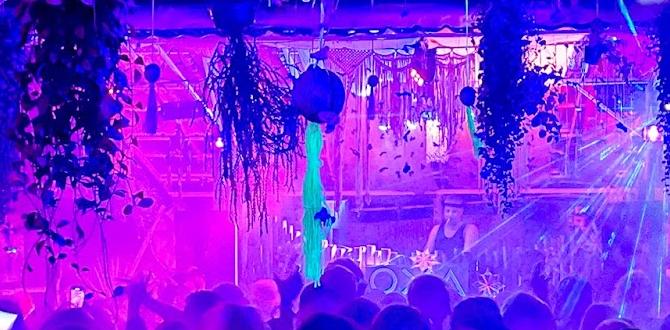Your 2-week Addis Ababa itinerary is here! See the best gems with this easy plan. Discover culture, history, and delicious food without the stress.
Welcome to Addis Ababa! Planning a trip can feel overwhelming, especially when you want to see the best of a new city in just two weeks. You might worry about missing out on key sights or spending too much time figuring out logistics. Don’t let that stop you! This guide is crafted to make your Addis Ababa adventure smooth and unforgettable. We’ll walk you through a proven itinerary packed with must-see gems, ensuring you experience the heart of Ethiopia’s vibrant capital. Get ready to explore history, culture, and amazing food with confidence.
Your Addis Ababa 2 Weeks Itinerary: Proven Must-See Gems
Planning an adventure in Addis Ababa for two weeks is a fantastic idea! It gives you ample time to soak in the city’s unique atmosphere, delve into its rich history, and savor its diverse flavors. This itinerary is designed to be flexible, allowing you to adjust based on your interests. Think of it as a friendly roadmap from a fellow traveler who’s been there and wants you to have the best experience. We’ll focus on making it easy, comfortable, and full of essential discoveries.
Week 1: Foundations and Culture
Your first week is all about getting acquainted with Addis Ababa – its history, its people, and its vibrant pulse.
Day 1: Arrival and Local Flavors
Morning/Afternoon: Arrive at Addis Ababa Bole International Airport (ADD). After clearing immigration and customs, head to your accommodation. A taxi or pre-booked shuttle is the easiest way to get to your hotel.
Travel Tip: If you’re managing essentials like adult diapers or child diapers for longer journeys, ensure they are easily accessible in your carry-on. This way, you can manage any immediate needs comfortably upon arrival without rummaging through checked luggage. Companies like Depend offer discreet and reliable options for adults, while brands like Pampers cater to children.
Late Afternoon: Settle in and take a short walk around your neighborhood to get a feel for the city.
Evening: Enjoy your first Ethiopian meal! Head to a local restaurant for authentic injera (a sourdough flatbread) with various stews (wots). Consider restaurants like Yod Abyssinia or Kategna for a welcoming atmosphere and traditional music and dance.
Day 2: Historical Heart
Morning: Begin at the National Museum of Ethiopia. This is home to “Lucy,” the remarkably preserved fossilized human skeleton. It’s a vital spot to understand Ethiopia’s ancient past.
SEO Boost: Explore “Lucy” at the National Museum to connect with ancient human history.
Afternoon: Visit the Holy Trinity Cathedral. This stunning cathedral is the final resting place of Emperor Haile Selassie and his wife, Empress Menen. The architecture and biblical art are breathtaking.
Late Afternoon: Wander through the Menelik II Square and see the statue of the emperor.
Evening: Try a different neighborhood for dinner. Piazza is known for its mix of modern and traditional eateries.
Day 3: A Taste of Tradition
Morning: Immerse yourself in the bustling Mercato, one of Africa’s largest open-air markets. It’s a sensory experience where you can find everything from spices and traditional crafts to electronics and live animals. Be mindful of your belongings and consider hiring a local guide for a better experience.
Practical Tip: When navigating crowded markets like Mercato, having a secure and easily accessible bag is key. Cross-body bags or backpacks with anti-theft features can provide peace of mind.
Afternoon: Explore the nearby Addis Ababa Market for souvenirs. You can find beautiful Ethiopian coffee, hand-woven textiles, and intricate silver jewelry.
Evening: Experience a traditional coffee ceremony at a local café. This is a significant cultural ritual, and it’s a wonderful way to slow down and connect.
Day 4: Art and Panoramas
Morning: Visit the National Gallery of Modern Art Ethiopia. It showcases the vibrant works of prominent Ethiopian artists, offering a glimpse into the country’s contemporary creative scene.
Afternoon: Head to Entoto Hill. You can drive or hike up for panoramic views of Addis Ababa. At the top, visit the Entoto St. Mary Church and the Emperor Menelik II Palace Museum. The views are spectacular, especially in the late afternoon light.
Evening: Enjoy dinner with a view from one of the restaurants on Entoto Hill or back in the city.
Day 5: Political and Social History
Morning: Visit the Red Terror Martyrs’ Memorial Museum (Yekatit 12 Monument). This museum powerfully documents the brutal regime of the Derg and the struggles of the Ethiopian people. It’s a somber but important reminder of recent history.
External Link: Learn more about Ethiopia’s political history from the Ethiopia Heritage website.
Afternoon: Explore the Merkato Cultural Centre for a more curated insight into Ethiopian crafts and traditions, often less overwhelming than the main market.
Evening: Consider trying a restaurant specializing in seafood, a growing trend in Addis Ababa, or revisit a favorite spot from earlier in the week.
Day 6: Learning Lenses
Morning: Visit the Sheger Park and the Friendship Square. This modern park offers green space and a chance to see a different side of Addis.
Afternoon: If you’re interested in learning more about Ethiopian culture and languages, consider visiting a local cultural center or language school for a brief introductory session. This can add an enriching layer to your understanding.
Evening: Enjoy a relaxed evening. Perhaps visit a local bar for a taste of Ethiopian beer like St. George or Dashen.
Day 7: Wildlife and Relaxation
Full Day Trip: Take a day trip to the Awash National Park (about a 3-hour drive). While a bit of a drive, it offers a chance to see Ethiopian wildlife like baboons, gazelles, and diverse bird species in a more natural setting. You can also see hot springs.
Travel Planning: Day trips require planning. Ensure you have transport arranged, a guide if possible, and pack plenty of water and snacks.
Evening: Return to Addis Ababa. Enjoy a quiet dinner after a day of adventure.
Week 2: Exploration and Depth
The second week allows for deeper dives into specific interests, day trips, and revisiting favorite spots.
Day 8: Culinary Journey
Morning: Take a hands-on Ethiopian cooking class. This is a fun way to learn how to prepare traditional dishes like injera, lentil wots, and doro wot. Many classes include a market visit.
Afternoon: Enjoy the fruits of your labor from the cooking class for lunch!
Evening: Explore the Bole area, known for its more upscale restaurants and contemporary Ethiopian cuisine.
Day 9: Cultural Institutions
Morning: Visit the Ethiopian Ethnological Museum, which was once the palace of Emperor Haile Selassie. It provides excellent insights into the diverse ethnic groups and cultures of Ethiopia.
Afternoon: Explore the Addis Ababa University. Even if you’re not a student, the campus often has interesting cultural events or displays, and it’s a hub of intellectual activity.
Evening: Attend a performance at the National Theatre of Ethiopia if there’s a show scheduled.
Day 10: Day Trip to Horr Gebel
Full Day Trip: Venture to Horr Gebel (approx. 3-4 hours drive). This area offers a glimpse into rural Ethiopian life and landscapes. It’s a great opportunity for hiking and experiencing the countryside.
What to Pack: For rural excursions, comfortable walking shoes, sun protection (hat, sunscreen), insect repellent, and a basic first-aid kit are essential.
Evening: Casual dinner back in Addis Ababa.
Day 11: Religious and Spiritual Sites
Morning: Visit the St. George’s Cathedral. Another significant religious landmark with beautiful frescoes and a treasury.
Afternoon: Explore the Grand Anwar Mosque, a prominent Islamic landmark in the city, showcasing the religious diversity of Ethiopia.
Evening: Relax or do some souvenir shopping. Consider the smaller craft shops for unique finds.
Day 12: Modern Addis
Morning: Explore the Meskel Square area. This is often a site for festivals and national celebrations.
Afternoon: Visit a contemporary art gallery or enjoy a leisurely coffee at a trendy café in the Kazanchis or CMC areas.
Evening: Consider a rooftop bar for sunset drinks and city views.
Day 13: A Bit of Everything
Morning: Revisit a favorite spot or explore a neighborhood you haven’t seen yet. Perhaps the Arat Kilo University area has interesting architecture.
Afternoon: Do any last-minute souvenir shopping. Focus on authentic crafts and local products.
Evening: Enjoy a farewell dinner at a restaurant you enjoyed or try one recommended by locals for a truly insider experience.
Day 14: Departure
Morning: Enjoy a final Ethiopian breakfast. Depending on your flight schedule, you might have time for a last stroll or a quick visit to a local park.
Afternoon: Head to Addis Ababa Bole International Airport (ADD) for your departure.
Departure Ready: If you’ve been using adult or child diapers, ensure you have a discreet way to manage any final needs before heading to the airport. Many travel companions find disposable bags or small pouches useful for discreet disposal.
Essential Addis Ababa Experience Summary
This 2-week Addis Ababa itinerary covers historical landmarks like the National Museum and Holy Trinity Cathedral, vibrant markets like Mercato, cultural immersion at Entoto Hill and local cafes, and day trips for nature and rural life. It ensures a comprehensive and well-rounded exploration of Ethiopia’s capital, balancing key sights with authentic cultural experiences.
Planning Your Trip: Accommodation and Transportation
When planning your two-week stay, choosing the right accommodation and understanding transportation are key to a smooth journey.
Accommodation Options
Addis Ababa offers a range of places to stay, from luxury hotels to budget-friendly guesthouses.
Luxury: Hotels like the Hyatt Regency, Radisson Blu, and Sheraton Addis offer excellent amenities, services, and comfort. They are ideal for those seeking indulgence and convenience.
Mid-Range: Many comfortable hotels and guesthouses fall into this category. Look for places in areas like Bole, Kazanchis, or near the UN ECA. They provide good value and often include breakfast.
Budget: Guesthouses and smaller hotels offer basic but clean accommodations. These are great for solo travelers or those watching their budget.
Transportation in Addis Ababa
Getting around Addis Ababa can be an adventure in itself!
Taxis: Metered taxis are widely available. Always ensure the meter is used, or agree on a fare before starting your journey. Ride-hailing apps like Ride are also popular and can be very convenient.
Buses: Public buses are the cheapest option but can be crowded and challenging for tourists to navigate.
Minibusses (Ladas): These are ubiquitous for local travel but can be chaotic. They operate on fixed routes and are very affordable.
Walking: Possible in certain, well-defined neighborhoods for short distances, but Addis is a sprawling city.
Car Rental with Driver: For longer day trips or if you prefer maximum convenience, hiring a car with a driver is a popular option. This can be arranged through your hotel or a local tour operator.
Food and Drink: Must-Tries
Ethiopian cuisine is a highlight of any visit. Be adventurous and try as much as you can!
Iconic Dishes
Injera: The staple. A spongy, sour flatbread made from teff flour. Eaten with almost everything.
Wots: Stews, often spicy, made with meat (beef, lamb, chicken) or lentils and vegetables. The most famous is Doro Wat, a spicy chicken stew.
Tibs: Sautéed meat (beef or lamb) cooked with onions, peppers, and spices. Can be dry or saucy.
Kitfo: Minced raw beef seasoned with spices like mitmita (chili powder) and niter kibbeh (spiced clarified butter). Often served with injera and cheese.
Sambusa: Savory fried pastries similar to samosas, filled with lentils or minced meat.
Drinks to Try
Ethiopian Coffee: Renowned worldwide. Experience a traditional coffee ceremony.
Tej: A traditional honey wine, often served in a special flask.
Ethiopian Beer: St. George, Dashen, and Meta are popular local brands.
Cultural Etiquette and Useful Tips
Understanding local customs will enhance your experience and help you connect with people.
Greetings and Interactions
Greetings: A handshake is common, but a slight bow with your right hand over your heart is a respectful gesture.
Respect Elders: Show deference to older people.
Modesty: Dress modestly, especially when visiting religious sites. Shoulders and knees should be covered.
Right Hand: Use your right hand to eat or hand over items, as the left hand is considered unclean.
Safety and Health
General Safety: Addis Ababa is generally safe for tourists, but like any large city, be aware of your surroundings, especially in crowded areas. Avoid displaying expensive jewelry or large amounts of cash.
Tap Water: It’s advisable to drink bottled or purified water.
Food Safety: Eat at reputable restaurants. Injera is fermented and generally safe. Ensure hot food is served hot.
Getting Diaper Assistance: For travelers who require adult or child diapers, it’s wise to pack ample supplies. If you run out or need a specific type, inquire at larger pharmacies (like those in Bole or near major hotels) or specialty medical supply stores. However, carrying a sufficient supply from home is the least stressful option.
Connectivity and Money
Currency: The Ethiopian Birr (ETB).
ATMs: Available in Addis Ababa, especially in Bole and city centers, but can be unreliable.
Exchanging Money: It’s best to exchange currency at banks or authorized exchange bureaus. Major hotels may also offer exchange services.
Credit Cards: Accepted in larger hotels, restaurants, and supermarkets, but cash is king for smaller purchases and in markets.
SIM Cards: You can buy local SIM cards for your phone at the airport or shops, offering much cheaper data rates than international roaming.
FAQs about Addis Ababa 2 Weeks Itinerary
What is the best time of year to visit Addis Ababa?
The best time to visit Addis Ababa is during the dry seasons, from September to February. The weather is pleasant, with sunny days and cooler evenings, making it ideal for sightseeing and exploring.
Is Addis Ababa safe for solo travelers?
Addis Ababa is generally safe for solo travelers, but it’s important to exercise common sense precautions. Stick to well-lit areas at night, be aware of your surroundings, and avoid displaying valuables. Using reputable taxis or ride-sharing apps is recommended.
<






